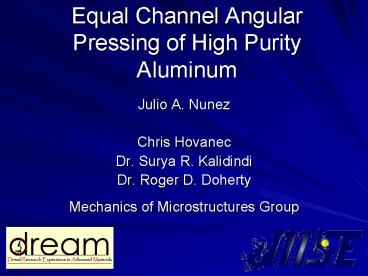Equal Channel Angular Pressing of High Purity Aluminum - PowerPoint PPT Presentation
1 / 20
Title:
Equal Channel Angular Pressing of High Purity Aluminum
Description:
The likelihood that ultra fine grain aluminum and its alloys can ... Dodge Viper. F-22. High. Thrust. Weight =Higher Acceleration. 10% Reduction/6% efficiency ... – PowerPoint PPT presentation
Number of Views:1577
Avg rating:3.0/5.0
Title: Equal Channel Angular Pressing of High Purity Aluminum
1
Equal Channel Angular Pressing of High Purity
Aluminum
- Julio A. Nunez
- Chris Hovanec
- Dr. Surya R. Kalidindi
- Dr. Roger D. Doherty
- Mechanics of Microstructures Group
2
Equal Channel Angular Pressing(ECAP)
- Deformation process that imposes high strains
with the benefit of retaining the cross-sectional
area of the work piece.
Shear Plane
3
Motivation
- The likelihood that ultra fine grain aluminum and
its alloys can be produced by ECAP processing
with both increased strength and fracture
toughness. - To achieve a more in-depth understanding of the
physical mechanisms behind the evolution of grain
size and shape during severe plastic deformation.
4
Social/Economical
F-22
Space Shuttle
10 Reduction/6 efficiency
Thrust
High
Higher Acceleration
Weight
Dodge Viper
5
Microstructure Performance
Performance
Processing
Microstructure
6
Two Ways to Strengthen Metals
- Precipitation Hardening
- Strain Hardening
7
Precipitation Hardening
- Precipitation Hardening is a thermodynamic
reaction that involves creation of a new phase
change - Precipitation Heat Treatment
- precipitates form on grain boundaries
- lower fracture toughness compared to strain
hardening
Grain Boundaries
8
Strain Hardening
- Strain Hardening occurs when a ductile metal
becomes harder and stronger as it is plastically
deformed - rolling, compression, and ECAP
9
Rolling
- Widely used for strain hardening
- Pass a piece of metal between two rolls
- Although imposes strain on the metal, it reduces
thickness - Sample thickness limits amount of strain induced
10
Aluminum
- Generally precipitation heat treated because of
inherent properties - Lowers fracture toughness
- Dr. Doherty and colleagues discovered high solute
alloys increase fracture toughness when strained
11
ECAP
- Same strength as precipitation hardening but
higher fracture toughness - Rolling e 2.3 VS. ECAP e 10
12
Objectives
- Successfully process high purity Al by ECAP to
high strains - Extract mechanical properties as a function of
imposed strain - Extract mechanical properties as a function of
microstructure - Validate the MMG ECAP process through comparisons
of experimental data published data
13
Procedure
- Run each sample twice and heat treat at 450C for
1hr - Run ten samples to different strains through
route A - Cut samples
- Run compression test
- Perform metallography to measure grain size and
analyze texture
14
Microstructure
- Metallography is the process of preparing samples
such that any deform or unrepresented surface is
removed so the specimen is ready for analysis. - Grain Size
- Texture OIM (measure of crystal orientations).
SEM
OIM
15
Grinding wheel
Grinding/Polishing
- Grinding is done on a spinning wheel with water
running on the surface. - Round SiC grinding paper are used to scratch the
surface with all the lines going in one
direction. - Polishing creates a smooth, mirror-like finish.
- Non-abrasive cloth is used and lubricant is added
and a diamond suspension which acts as grit.
Different grit papers
Cloth, lubricant, and diamond suspension
16
Mechanical Properties
- Theoretically we expect the envelope expand to
the right
Fracture Toughness
KIC
Yield Strength
sy
17
Mechanical Properties
- Theoretically we expect the envelope expand to
the right
Fracture Toughness
KIC
Yield Strength
sy
18
Results
- Results from testing will be used to compare
data from previous published findings. - If the data correlates, this will validate proper
technique and give us a base line for our overall
project.
19
Thank You
20
Dislocations
Linear or one dimensional defects where some of
the atoms are misaligned.































